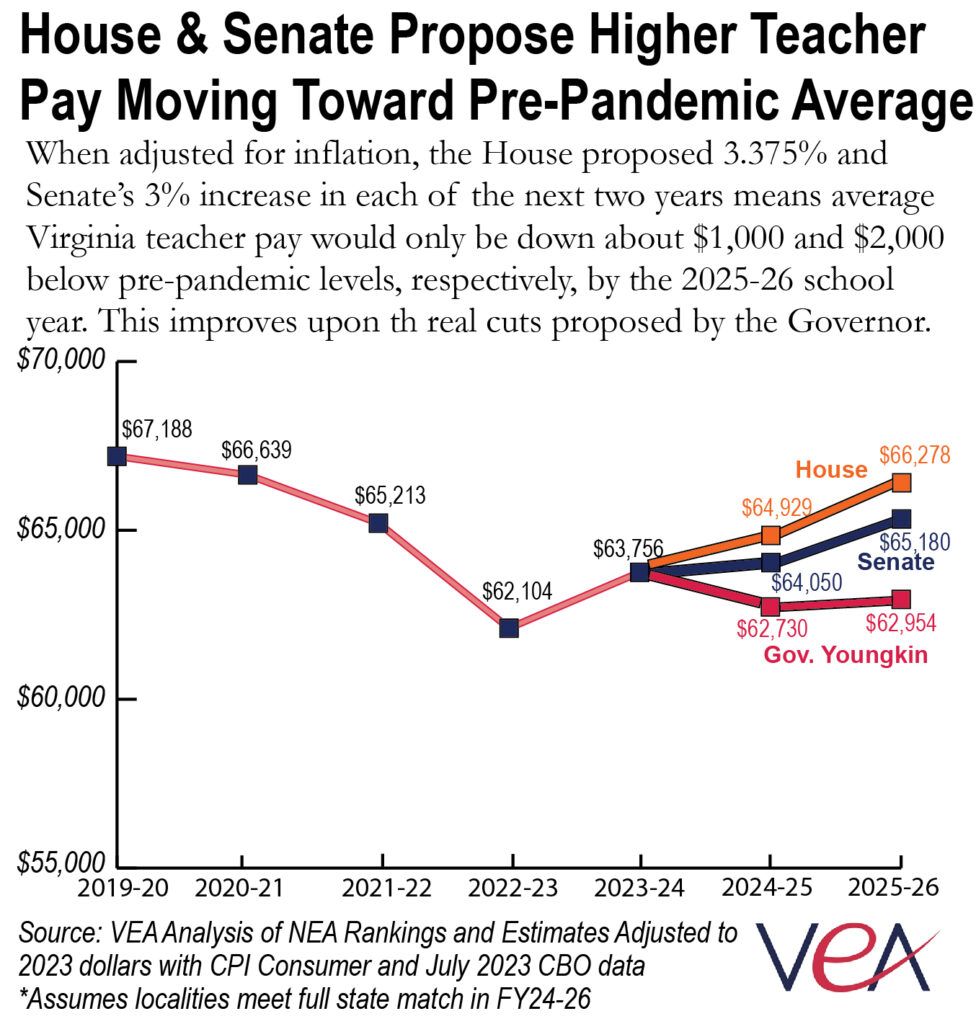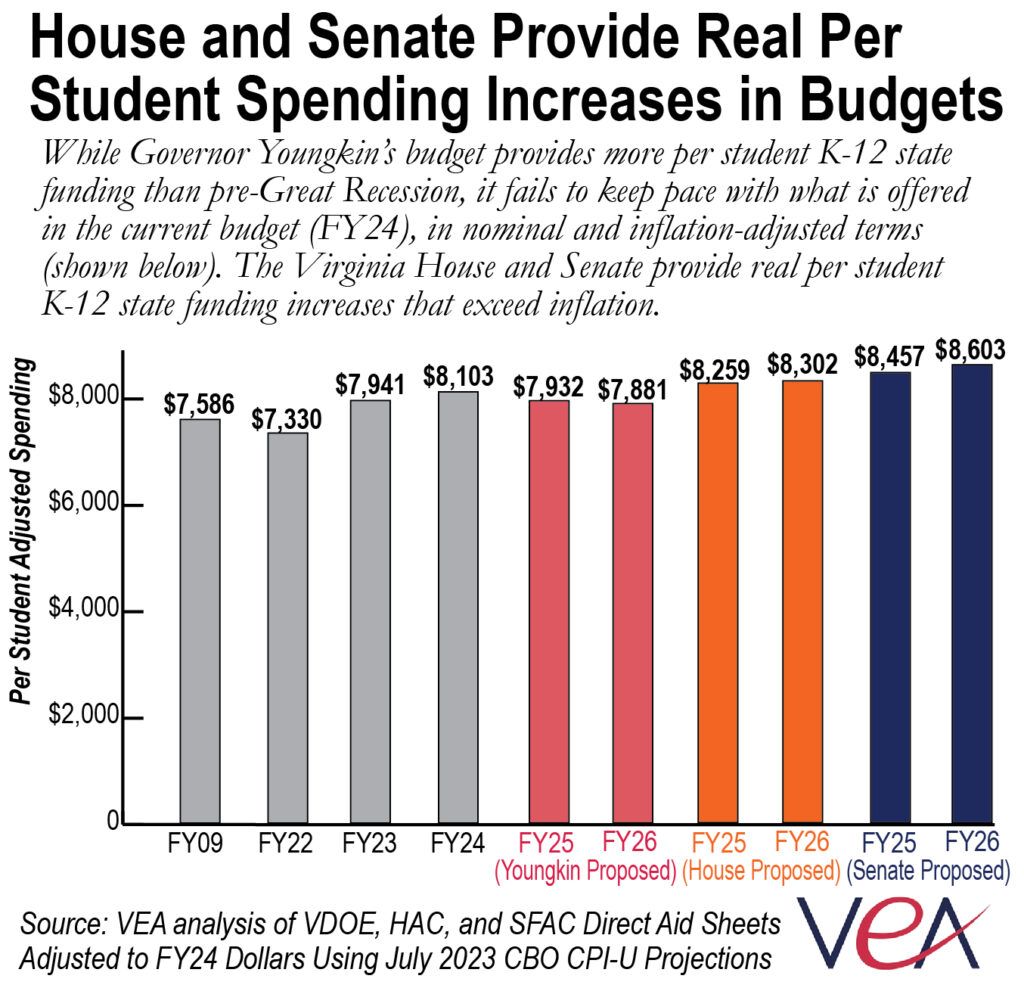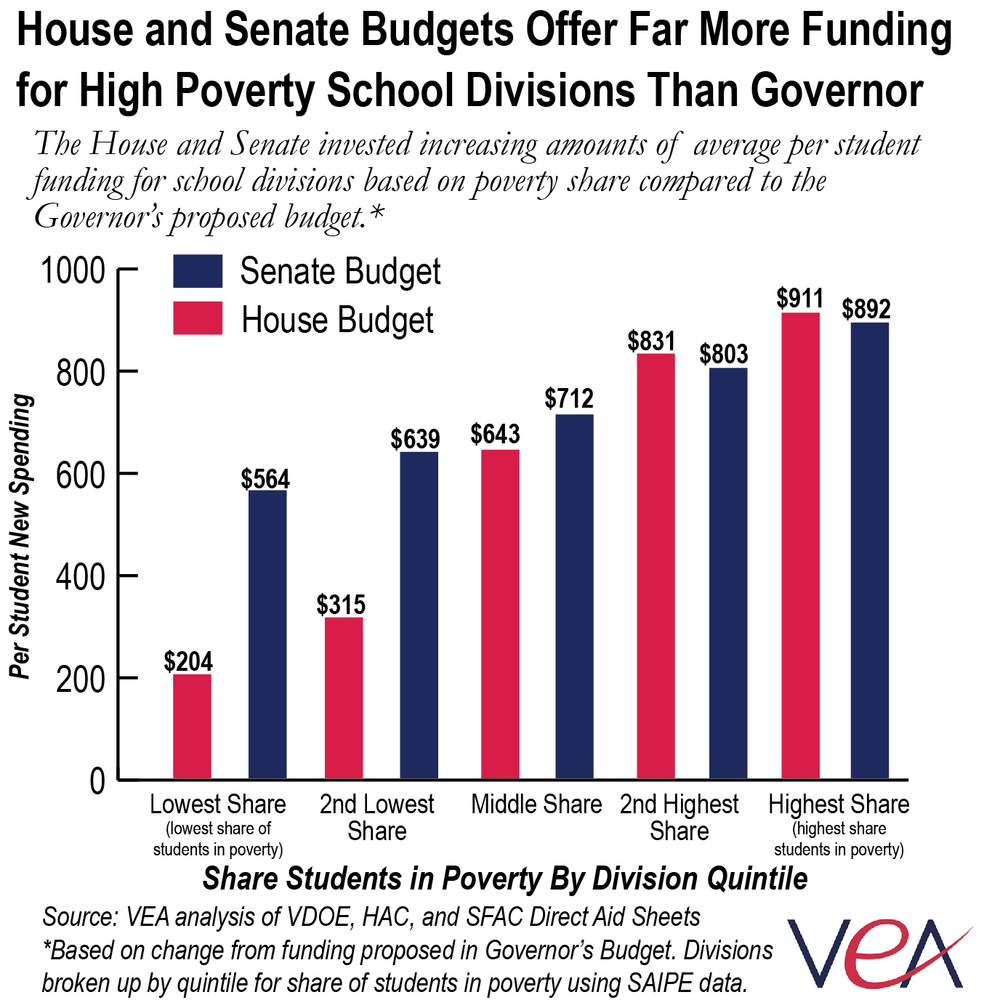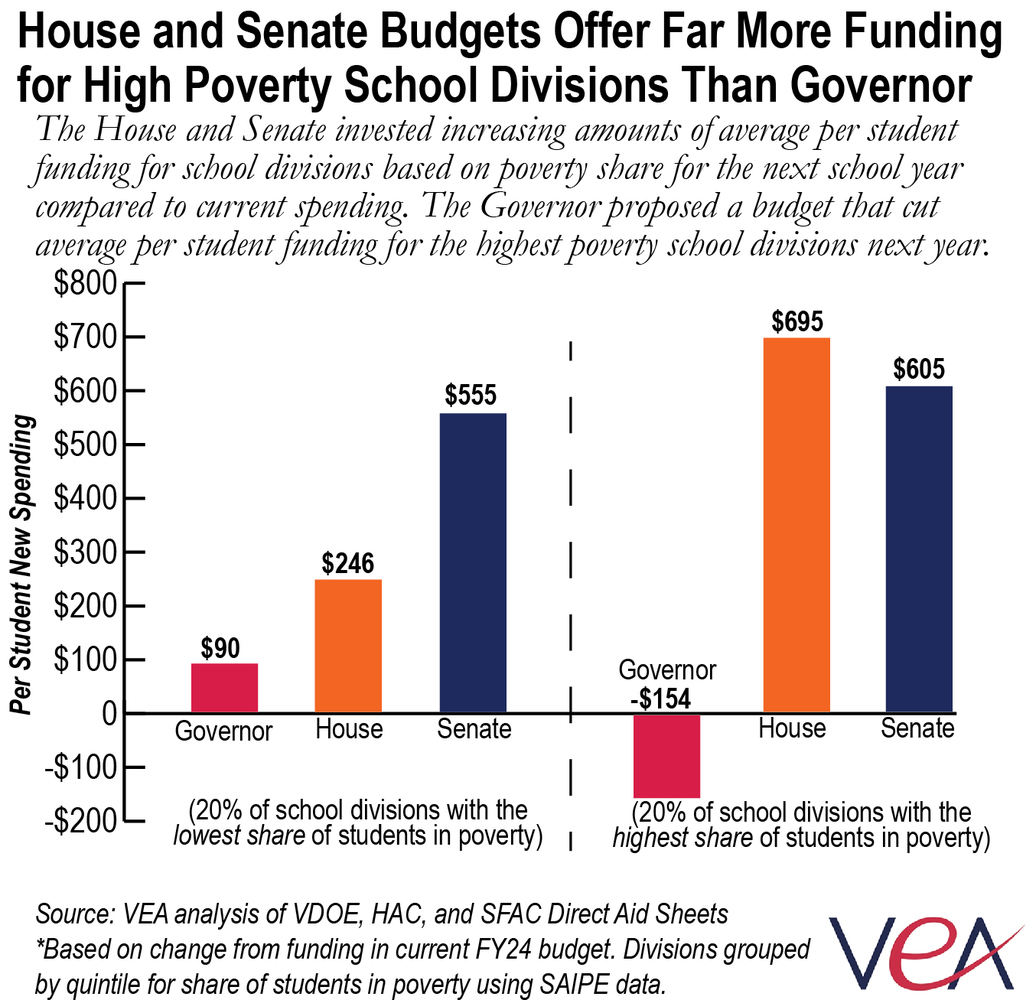VEA on House & Senate Budgets: ‘A Step in the Right Direction’
February 19, 2024
February 19, 2024
Richmond, VA – Earlier today, the Virginia House and Senate released their respective two-year state budget proposals as alternatives to what Governor Youngkin submitted in December 2023. Overall, the House proposed around $1 billion and the Senate $1.7 billion above what the Governor offered for K-12 spending over the next two years. Both chambers reversed the effects of some of the most regressive tax policy choices in the Youngkin budget and chose to lessen the negative impact on working families. Absent the will for significant revenue-raising measures in either budget, neither chamber was able to lift all of the gimmicks in the Governor’s budget that supplanted K-12 funding or propose investments to get Virginia to the national teacher pay average in this biennium.
In response to the proposed Senate and House budgets, Dr. James Fedderman, President of the Virginia Education Association said: “Both the House and the Senate proposed meaningful improvements to our overall state funding for schools compared to the cuts in Governor Youngkin’s budget. While these budgets are a step in the right direction, unless state lawmakers recognize and are willing to raise adequate revenue to ultimately meet the needs of all students in our Commonwealth, VEA members fear we will continue to tread water when it comes to addressing the JLARC recommendations and boosting competitive pay to get Virginia educators on par with other comparable professions.”
Below, we detail some of the most significant K-12 changes proposed in the chamber budgets.
Senate Responds to Shortchanging Gimmicks from Governor’s Budget
The Senate proposed unwinding some of the most egregious gimmicks in Governor Youngkin’s budget that short-changed our schools. The Senate proposed restoring the promised funding to hold divisions harmless for reductions in the grocery tax made in the previous state budget (+$243M). Furthermore, the Senate provided additional funding for school construction by reversing the supplanting of the Literary Fund which was being used to cover teacher retirement in Governor Youngkin’s budget (+$300M). The Senate also directed a new tax stream towards K-12 direct aid from a New Economy Tax (+$218M).

Unfortunately, the House did not follow suit and maintained most of the budget gimmicks. Both chambers failed to replace the $388 million that Governor Youngkin supplanted in his budget. This budget gimmick penalizes local schools dollar for dollar for the money they received in the last round of federal pandemic aid. This budget gimmick shortchanges our most vulnerable high-poverty schools the most and lawmakers and the public should take note and demand that our schools be held harmless for the federal pandemic aid they received.
Improvements In Salary, But Still Below Pre-Pandemic Levels and Far Below National Average
The House proposed 3.375% salary increases in each of the next two school years for state-supported school positions, while the Senate proposed 3% next school year (effective October 1, 2024) and 3% the following year (effective July 1, 2025). Unlike the Governor’s proposed budget, both the House and Senate pay raise proposals keep up with inflation and even exceed it in the second year. These increases are far short of getting Virginia to the national teacher pay average, and will even be below the Virginia teacher pay average before the pandemic (see graph below). It has been a stated goal during this legislative session by leaders in each chamber to get to the national teacher pay average, and it seems like they now aim to get there by the end of the 2027-28 school year. While this is a major improvement from the effective pay cuts proposed by Governor Youngkin, it’s still short of what’s needed to address our current record-breaking teacher shortages occurring throughout the state.

Support Cap
The Senate’s next largest investment was $401 million to fully lift the arbitrary cap on school support staff, which was implemented as a co
st-saving measure during the Great Recession and has resulted in the loss of billions of dollars in state support to our local school divisions over time. Fully lifting the support cap has been a goal of education advocates for years and was a recommendation in last summer’s JLARC report (which showed Virginia was severely underfunding education). The House did not address lifting the support cap in its proposal today.
JLARC Recommendations and Impact of Students Facing Additional Barriers
Without meaningful revenue reform, neither chamber was able to make significant progress on funding the recommendations outlined in the seminal report released in the summer of 2023 from the General Assembly’s independent research group, JLARC, on the significant shortcomings of the state K-12 funding formula.
The House made a meaningful new investment in tiered support for English Learner students based on English proficiency levels (+$95M). The Senate proposed a more modest investment to simply increase the ratio of instructors for English learners for all students slightly (+$27M). While neither of these investments provides the flexibility nor the sufficient amount indicated in the JLARC report, they do respond to the critical need for additional support for these students.
The House also made a significant investment of $385 million in updating the state At-Risk Add-On, using parts of the methodology proposed by JLARC for better funding students identified as “economically disadvantaged.” Likewise, the Senate invested $370 million for high-poverty school divisions and per-student funding for students from low-income families (details still pending as of February 18th, but this is similar to At-Risk Add-On). While this funding helps correct for years of underfunding high-need schools in Virginia, its impact is diminished by the fact that both chambers continue to supplant the $388 million of federal pandemic aid to schools in their budget. This federal aid was allocated largely based on shares of students living in poverty. For many divisions, this will cancel out or exceed the new proposed At-Risk Add-On funding.
 House and Senate Budgets Provide Substantially More K-12 Funding for Schools and Help Students Who Face the Most Barriers to Education
House and Senate Budgets Provide Substantially More K-12 Funding for Schools and Help Students Who Face the Most Barriers to Education
While the Senate has not released their distributional tables for direct aid impact by division as of February 18th, they did have a net K-12 increase beyond what the House included. The Senate budget also included several targeted items that will benefit school divisions with higher shares of economically disadvantaged students the most.
On the House side, the data is in and it’s clear the new investments improve overall equity in our K-12 system. The House provides an additional $335 more per student on average in the next school year and $442 in the 2025-26 school year compared to the governor’s proposed budget.
The House budget provides $911 more per student on average over each of the next two years than the governor’s proposed budget for students in school divisions with the highest share of poverty, and $820 more per student in divisions with the highest share of Black students. When it comes to geography, the House budget provides an average of an additional $573 per student compared to the governor’s budget for rural schools over each of the next two years, which is higher than an average of $339 for non-rural schools. Choices to invest in the At-Risk Add-On and English learner students helped improve the overall equity of the distribution of the K-12 state funding.

Teacher shortages are a serious issue across the country. Here in Virginia, there are currently over 3,648 unfilled teaching positions. (FY23)
Learn More